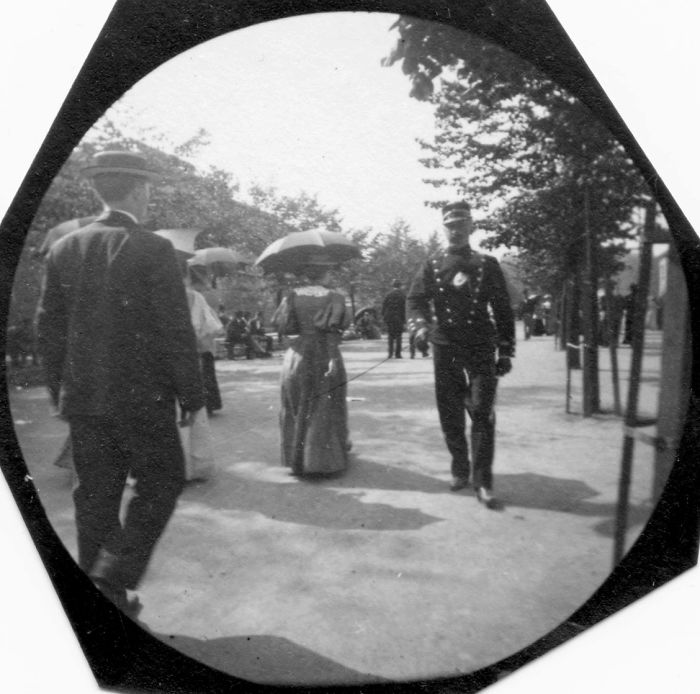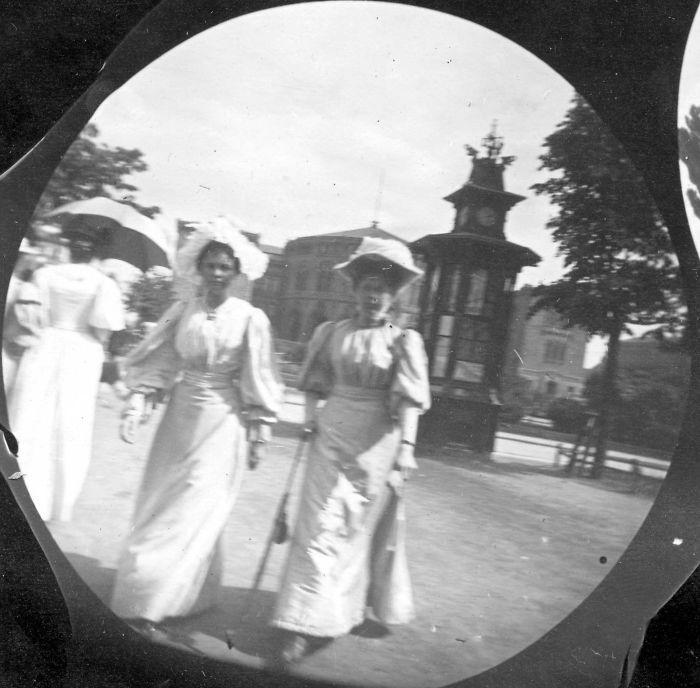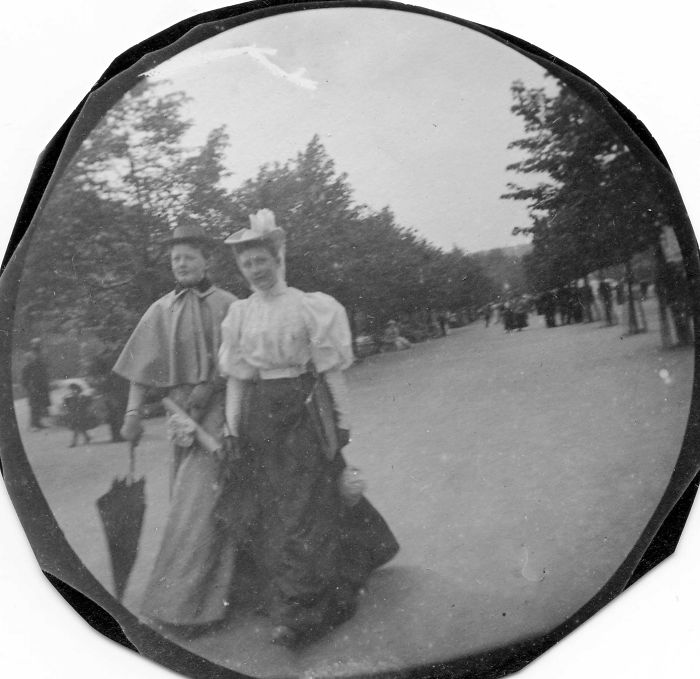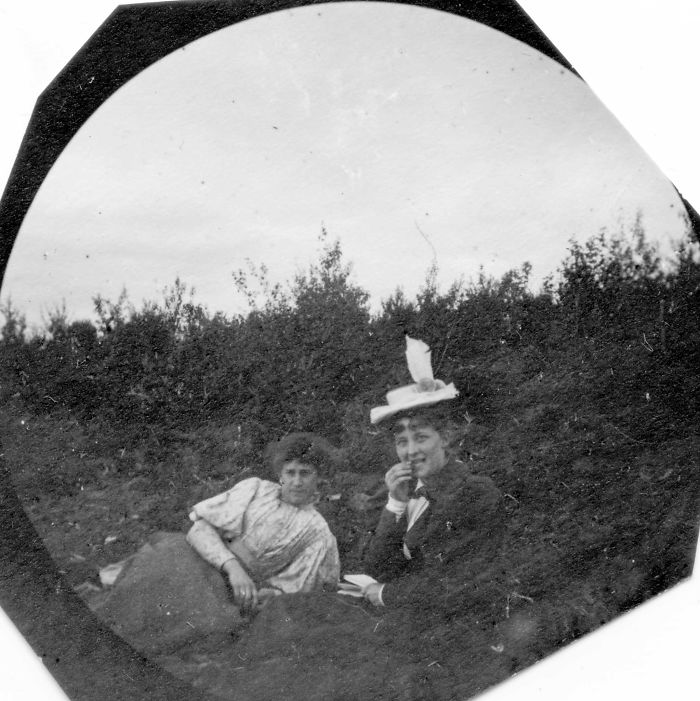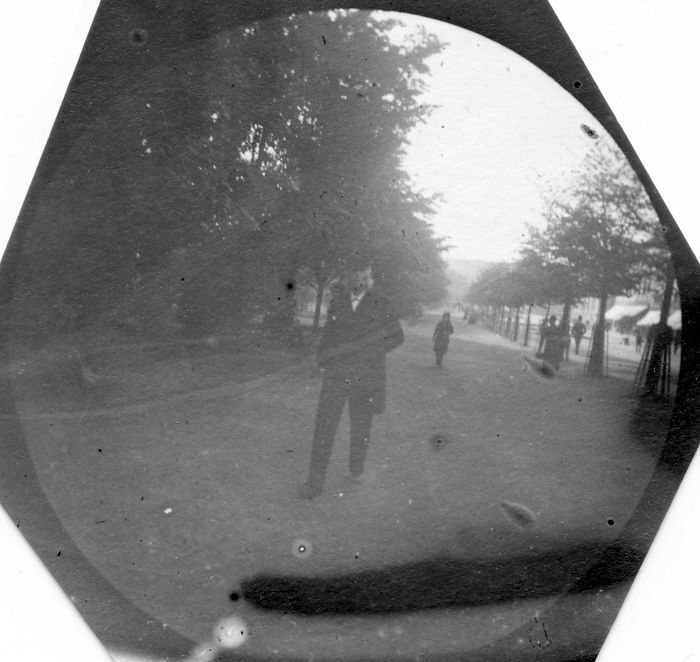
19-Year-Old Student Hides Spy Camera In His Clothing To Take Secret Street Photos In The 1890s
Carl Størmer (1872-1957) enjoyed a hobby that was very, very unusual at the time. He walked around Oslo, Norway in the 1890s with his spy camera and secretly took everyday pictures of people. The subjects in Størmer's pictures appear in their natural state. These street photography shots extremely differ from the grave and strict posing trends that dominated photography during those years.
Carl got his C.P. Stirn Concealed Vest spy camera in 1893 when he was studying mathematics at the Royal Frederick University (now, University of Oslo). "It was a round flat canister hidden under the vest with the lens sticking out through a buttonhole," he told St. Hallvard Journal in 1942. "Under my clothes, I had a string down through a hole in my trouser pocket, and when I pulled the string the secret camera took a photo."
Norway's first paparazzi usually photographed people at the exact time they were greeting him on the street. "I strolled down Carl Johan, found me a victim, greeted, got a gentle smile, and pulled. Six images at a time and then I went home to switch [the] plate." In total, Størmer took a total of about 500 of these black and white photos.
His interesting photos aside, Størmer was also fascinated with science. He was a mathematician and physicist, known both for his work in number theory and studying the Northern Lights (Aurora Borealis).
Now scroll down below and check these secret vintage photos of Norway's past for yourself!
This post may include affiliate links.
This is physics professor Kristian Birkeland - the only one of Størmer's subjects to rumble him. Apparently he got quite cross!
I love the hats on these women. Holy c**p, they're enormous. Replace the background with a promenade deck or something it's like a scene out of Titanic.
i love this one, i like to think he can see the camera and is tipping his hat to the guy
Wow!! What a striking figure she cuts. Would love to have a closer look at what she is holding--is it a purse?
Why don't we use parasols for shade anymore? I grew up in Minnesota near a large community of Hmong. The older women (and sometimes men) would often carry umbrellas in the summer to keep the sun off. I envied them, because I was a teenager and wouldn't have dared because it wasn't "done". (Nobody even used them in the rain at the time because humans are silly at times.)
Good Scandinavian diet. Few processed foods, not a lot of fat and no junk food!
That really looks like Henrik Ibsen! https://en.wikipedia.org/wiki/Henrik_Ibsen
The whole city looks so pretty, why aren´t we today, with our machines, building this pretty buildings anymore? Would be way easier today then it was then.
Lena, I'm still not sure this is best way to escape the police..... Shut up Ollie and sway your hips more.
It's not just the time period, but the location. Leave North America and everyone is still generally 'slim'... aka normal to everyone else.
Load More Replies...Also, women were, on average, about 5 inches shorter, so most were barely 5 feet tall. And the average height for men was about 5’ 7”. Everyone was much narrower in the chest and hips. Most people now would not fit in the theater seats that were used around 1900. Better food production and storage (refrigeration) has allowed people in first world countries to grow taller. As an illustration, South Koreans are an average 4-5 inches taller than North Koreans, which started after the Korean War when it was split. People of both sexes in North Korea are required to join the military, but people are joining so they can depend on 1 meal a day. Better, more plentiful food makes a big difference.
It was so much harder for everyday life, most everyone was fairly slim. You barely got done with breakfast and had everything cleaned up when it was time to start lunch. When you got lunch cleaned up it was time to start supper. In between you did housecleaning with a broom, beating rugs, and heating water on a wood stove to wash clothes in a tub. No modern conveniences. Sometimes the women had to chop wood also, for the wood-burning kitchen stove. If a person was heavy, was usually of the upper class and had servants to do most of the work. Also the main way to get around was walking.
I wonder why almost every woman in the photos are smiling. Presumably they knew that he had a camera, but still.
I can't even imagine what a hassle it would have been to deal with a hat like that on a windy day.
"I thought you said your dog doesn't bite?!!" "Yes, but that's not my dog." <---one of my favorite Inspector Clouseau (Pink Panther) jokes.
People must have had buff arms in those days from all the hat tipping
I always pictured that most Norwegians were blond, but from these pictures, they look like most have brown hair. Might be it's just hard to tell in the b/w photos. Or, more likely, it's one more stereotype I need to delete from my files.
Oh dear, yet another time traveller with a cell phone caught on camera.
Partial double exposure. The cranking mechanism glitched out. Still: extraordinarily good photos for their time!
Apparently they didn't have spur of the moment quickies in those days. Too many clothes
Girl-Scouts? The hats, especially. Very practical clothes compared to some of the city scenes.
Power-dressing of the era. Or else they're time travelers who read the wrong brochure before arriving.
In Norway those days there were many nationalistic rallies until 1905 when independence from Sweden was gained.
There is a winter series, and a summer series. That's what I'm seeing.
Norway was know for sudden Land-Tilting. Everyone soon got used to it.
As soon as this guy leaves pass me the cigarettes and whiskey please.
Ingrid, I wish you had washed my pants earlier. So embarrassing to wear your mom's dress because I have no dry clothes.
A good time was had at the RideMan attraction and it was time to return home...
"Then, as you make your final approach, give it a bit of 'sizzle' - know wot I mean?"
I think he is the first heavy person I've seen (so far) in this series.
Two more views of Karl Stukker - the sad little man with a thing for trees.
Were you allowed to remove clothing in public? Those Scandinavians were so progressive.
Ordinary people, caught at the very moment they began fading from history.
It looks like those dudes' arms are linked? Probably a trick of the light but still...
This group almost looks like they knew about the camera and were posing.
It is amazing to me how well dressed everybody was. They took pride in their appearance. No but crack here folks...
I'm intrigued by several of his pix. Not of people but of places like this. Very ordinary places. I wonder what the significance was?
Cameras were a little large back in the day. A little hard to hide it.
Those are very clear photos. I find it surprising that he could get such a good photo given that the camera and the people were moving, especially given the technology of the time.
That is exactly what I was thinking. Most photos were so grim because of how long the film exposure needed to be.
Load More Replies...These are amazing. Candid photos make everyone seem more human and "real" than the posed portraits we're used to seeing. I love too how most of the young ladies respond to Mr. Størmer with such cute shy smiles.
One thing I notice is that the men mostly wore their hats on the top of their heads. When people are dressing up in 19th century clothes nowadays they typically pull the hat down to the top of their ears. I was born in the 1960s and can remember that it was not unusual for old men even then to have about a hand's-width space between his hat and the top of his ear.
Love these!!! The streets are so empty...these are a real treasure trove for historians, especially of costume. The women's clothes are amazing!!
Men's clothing hasn't changed that much, especially when compared to women's clothing.
I was thinking the same thing. A man could get away with wearing much of this (maybe not the top hat!)
Load More Replies...Its so weird how normal the photos feel. Stunning. Also, this is the first time I have seen a circular lense take circular photos(instead of squares)
The shape of the photo are a result of the shape of the film. The canister and film were circular in this case. The lens just projects an image on an area of film. The projection is slightly bigger than the film so that all of the film gets bathed in light.
Load More Replies...I don't normally view things with a gay/straight filter but I'm looking at these as a butch chick and I'd have been f****d royally. I look gay. I used to catch the "if you'd only wear a dress" noise from people but when I did dress "appropriately" people just kind of looked at me like... Why is that dy*e wearing a dress? 😐 I forget how hard it had to have been for those who came before me sometimes.
There are some super interesting photos of lesbians from this era, especially Victorian-era England. I wish I could remember the names so you could look them up--but try cross-dressing Victorians, and you might also want to try the lesbian districts in Paris. These dresses were a very effective beard--they provided a certain amount of freedom for women, and women also cross-dressed as identity cards and passports were not common. Women had more freedom in their sexuality than men at this time.
Load More Replies...BEST article on here in a while. I'm still smiling on the third page.
Absolute faszinating to look to peoples faces, they are gone for long time. But in the moment, you look at them, it seemed, that they are alive for that second, looking and smiling to you. I love that timerides to the past.
I need to more about these photos! I would love to study them. Which of these buildings are still standing.where are they in Oslo (the centre of town? a promenade district?). What was the population at the time? where are these photos kept? So exciting!
Most of the buildings you see in the background are still standing. Most of them along Karl Johan, the street leading up to the royal palace. This is in the center of town, and was the most fashionable area at the time, something that explains all the sharply dressed people. :)
Load More Replies...This is amazing. I mean, isn't it wonderful? A young person took photos some 100 years ago in Scandinavia. Did he think that some other person in a country far away that didn't even exist at his time will see the photos, all this while lying in bed with a smartphone?
I became so sad when the reality hit me; all of these people are dead. Every single person and dog in the photos is dead.
By 1880 film was sensitive enough that in full sunlight you could use a shutter speed under 1 second or faster, which is what is considered to be the slowest shutter speed to use by hand.
Where can I get one of these cameras? And will it shoot Kodacolor?
I suspect that not too many have noticed that he caught Ibsen walking around. - spy-camera..._700-1.jpg 
There are a couple of photos of him in this series
Load More Replies...fantastic great photos and so clear so things dont always get better with new gear, black and white are so good sometimes so much better than colour
Ah, no. This is a very famous collection of photos, which are now stored at the Norwegian National Library. Also, the photographers camera and other equipment are all well documented.
Load More Replies...Trigger happy, these photos were in 1890's Norway. things were not as progressive as they are now. This is why we need to have history taught in schools again as people have no concept of the historical timeline in relation to world events and the cultural revolution.
Load More Replies...Those are very clear photos. I find it surprising that he could get such a good photo given that the camera and the people were moving, especially given the technology of the time.
That is exactly what I was thinking. Most photos were so grim because of how long the film exposure needed to be.
Load More Replies...These are amazing. Candid photos make everyone seem more human and "real" than the posed portraits we're used to seeing. I love too how most of the young ladies respond to Mr. Størmer with such cute shy smiles.
One thing I notice is that the men mostly wore their hats on the top of their heads. When people are dressing up in 19th century clothes nowadays they typically pull the hat down to the top of their ears. I was born in the 1960s and can remember that it was not unusual for old men even then to have about a hand's-width space between his hat and the top of his ear.
Love these!!! The streets are so empty...these are a real treasure trove for historians, especially of costume. The women's clothes are amazing!!
Men's clothing hasn't changed that much, especially when compared to women's clothing.
I was thinking the same thing. A man could get away with wearing much of this (maybe not the top hat!)
Load More Replies...Its so weird how normal the photos feel. Stunning. Also, this is the first time I have seen a circular lense take circular photos(instead of squares)
The shape of the photo are a result of the shape of the film. The canister and film were circular in this case. The lens just projects an image on an area of film. The projection is slightly bigger than the film so that all of the film gets bathed in light.
Load More Replies...I don't normally view things with a gay/straight filter but I'm looking at these as a butch chick and I'd have been f****d royally. I look gay. I used to catch the "if you'd only wear a dress" noise from people but when I did dress "appropriately" people just kind of looked at me like... Why is that dy*e wearing a dress? 😐 I forget how hard it had to have been for those who came before me sometimes.
There are some super interesting photos of lesbians from this era, especially Victorian-era England. I wish I could remember the names so you could look them up--but try cross-dressing Victorians, and you might also want to try the lesbian districts in Paris. These dresses were a very effective beard--they provided a certain amount of freedom for women, and women also cross-dressed as identity cards and passports were not common. Women had more freedom in their sexuality than men at this time.
Load More Replies...BEST article on here in a while. I'm still smiling on the third page.
Absolute faszinating to look to peoples faces, they are gone for long time. But in the moment, you look at them, it seemed, that they are alive for that second, looking and smiling to you. I love that timerides to the past.
I need to more about these photos! I would love to study them. Which of these buildings are still standing.where are they in Oslo (the centre of town? a promenade district?). What was the population at the time? where are these photos kept? So exciting!
Most of the buildings you see in the background are still standing. Most of them along Karl Johan, the street leading up to the royal palace. This is in the center of town, and was the most fashionable area at the time, something that explains all the sharply dressed people. :)
Load More Replies...This is amazing. I mean, isn't it wonderful? A young person took photos some 100 years ago in Scandinavia. Did he think that some other person in a country far away that didn't even exist at his time will see the photos, all this while lying in bed with a smartphone?
I became so sad when the reality hit me; all of these people are dead. Every single person and dog in the photos is dead.
By 1880 film was sensitive enough that in full sunlight you could use a shutter speed under 1 second or faster, which is what is considered to be the slowest shutter speed to use by hand.
Where can I get one of these cameras? And will it shoot Kodacolor?
I suspect that not too many have noticed that he caught Ibsen walking around. - spy-camera..._700-1.jpg 
There are a couple of photos of him in this series
Load More Replies...fantastic great photos and so clear so things dont always get better with new gear, black and white are so good sometimes so much better than colour
Ah, no. This is a very famous collection of photos, which are now stored at the Norwegian National Library. Also, the photographers camera and other equipment are all well documented.
Load More Replies...Trigger happy, these photos were in 1890's Norway. things were not as progressive as they are now. This is why we need to have history taught in schools again as people have no concept of the historical timeline in relation to world events and the cultural revolution.
Load More Replies...
 Dark Mode
Dark Mode 

 No fees, cancel anytime
No fees, cancel anytime 




























































